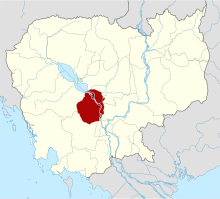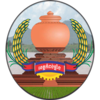Kampong Chhnang (Khmer: កំពង់ឆ្នាំង [kɑmpɔŋ cʰnaŋ]; meaning 'Port of Pottery') is one of the central provinces (khaet) of Cambodia. Neighboring provinces are (from north clockwise) Kampong Thom, Kampong Cham, Kandal, Kampong Speu, and Pursat. The provincial capital is the city of Kampong Chhnang.[2][3]
Kampong Chhnang
កំពង់ឆ្នាំង | |
|---|---|
| |
|
From top, clockwise: Kangrei Mountain, rural countryside, Wat Kampong Tralach Leu, paddy field | |
 | |
| Coordinates: 11°N 106°E / 11°N 106°E | |
| Country | |
| Provincial status | 1907 |
| Capital | Kampong Chhnang |
| Subdivisions | 7 districts; 1 municipality |
| Government | |
| • Type | Province |
| • Governor | Sun Sovannarith (CPP) |
| • National Assembly | 4 / 125
|
| Area | |
• Total | 5,521 km2 (2,132 sq mi) |
| • Rank | 14th |
| Population (2023)[1] | |
• Total | |
| • Rank | 13th |
| • Density | 95/km2 (250/sq mi) |
| • Rank | 14th |
| Time zone | UTC+7 (ICT) |
| ISO 3166 code | KH-4 |
| Website | www |
Etymology
editKampong Chhnang consists of two Khmer words, kampong (កំពង់ kâmpóng) means "port" or "harbor" and chhnang (ឆ្នាំង chhnăng) means "pottery". Both words combine together meaning "Port of Pottery" or "Pottery Harbor".
Geography
editKampong Chhnang is a small province 91 kilometres (57 mi) from Phnom Penh. It is in the alluvial plain of central Cambodia and is drained by the Tonle Sap, a tributary of the Mekong river. The capital city of Phnom Penh has grown until it actually encompasses the provincial border of Kampong Chhnang.[4]
Religion
editReligion in Kampong Chhnang province (2019 census)[5]
The state religion is Theravada Buddhism. More than 93.1% of the people in Kampong Chhnang province are Buddhists. About 5.8% population of Kampong Chhnang province follow Islam followed by Chams. Christianity is followed by 0.3% in the province, then animism or other religions followed by 0.9%.
Kampong Chhnang is the main center for the Kan Imam San religious community, a type of Islam practiced exclusively by some Chams in isolated communities in Cambodia. There are 16 Kan Imam San villages in Kampong Chhnang province. The leaders of the community live and pray near Kampong Tralech.[6]
History
editThe name translates from Khmer literally to Port of Pottery. Archaeological remains from the area have revealed among many other findings artifacts from Dvaravati, a former kingdom in present-day Thailand, dating to the 6th through 11th centuries.[7]
Kampong Chhnang province centuries ago was a coastal city on the route between China and India; due to sedimentation from the Mekong river, the coast line moved much farther to sea. When the Tonle Sap river changed its course, the city lost its main water source and thus was deserted, the population moving to a city called Kampong Tralach. A city gradually formed around it, bring new life to Kampong Chhnang. A museum presents the archaeological record of the city's history.
Symbols
editThe provincial tree is Diospyros decandra. The provincial slogan is sweet pomelos, delicious rice, beautiful young ladies.[citation needed]
Administrative divisions
editThe province is subdivided into 7 districts and 1 municipality. The districts are further subdivided into 65 communes (khum) and 478 villages (phum). There is one city and 14 townships. There are also 102 khum administrative organizations (KAO).[8][9][10]
| ISO code | District | Khmer | Population (2019)[11] |
|---|---|---|---|
| 04-01 | Baribo | ស្រុកបរិបូណ៌ | 55,371 |
| 04-02 | Chol Kiri | ស្រុកជលគីរី | 31,322 |
| 04-03 | Kampong Chhnang Municipality | ក្រុងកំពង់ឆ្នាំង | 41,080 |
| 04-04 | Kampong Leng | ស្រុកកំពង់លែង | 44,066 |
| 04-05 | Kampong Tralach | ស្រុកកំពង់ត្រឡាច | 99,356 |
| 04-06 | Rolea Bier | ស្រុករលាប្អៀរ | 103,219 |
| 04-07 | Samakki Meanchey | ស្រុកសាមគ្គីមានជ័យ | 81,197 |
| 04-08 | Teuk Phos | ស្រុកទឹកផុស | 62,287 |
References
edit- ^ "General Population Census of the Kingdom of Cambodia 2019 – Final Results" (PDF). National Institute of Statistics. Ministry of Planning. 26 January 2021. Retrieved 3 February 2021.
- ^ "The Official Tourism website of Kampong Chhnang, Cambodia". Kampong Chhnang Official Tourism Website. Archived from the original on December 20, 2016. Retrieved December 3, 2016.
- ^ "Introduction - Kampong Chhnang, Cambodia". Tourism of Cambodia. Retrieved December 3, 2016.
- ^ "Geography - Kampong Chhnang, Cambodia". Tourism of Cambodia. Retrieved December 3, 2016.
- ^ "General Population census of the Kingdom of Cambodia 2019" (PDF). National Institute of Statistics Ministry of planning. October 2020.
- ^ "Cambodia's Unique Islamic Sect Fights to Resist Assimilation". thediplomat.com. Retrieved 2024-03-25.
- ^ "Kampong Chhnang province Trip Planner". Inspirock. Retrieved 2021-04-21.
- ^ "Kampong Chhnang Province" (PDF). Cambodia investment. Archived from the original (PDF) on December 20, 2016. Retrieved December 3, 2016.
- ^ "Map 4. Administrative Areas in Kampong Chhnang Province by District and Commune" (PDF). Stat Gov Japan. Archived from the original on February 7, 2013. Retrieved December 3, 2016.
{{cite web}}: CS1 maint: bot: original URL status unknown (link) - ^ "Map - Kampong Chhnang, Cambodia". Canby Publications Co. Retrieved December 3, 2016.
- ^ https://www.nis.gov.kh/nis/Census2019/Final%20General%20Population%20Census%202019-English.pdf [bare URL PDF]
External links
edit- Beyond Angkor: Historical Sites in Kampong Chhnang Province - Unique Graphical Interactive Maps and info about all the ancient historical sites
- Survey of Rice Cropping Systems in Kampong Chhnang Province, Cambodia




